2017 NISSAN LEAF service indicator
[x] Cancel search: service indicatorPage 188 of 424
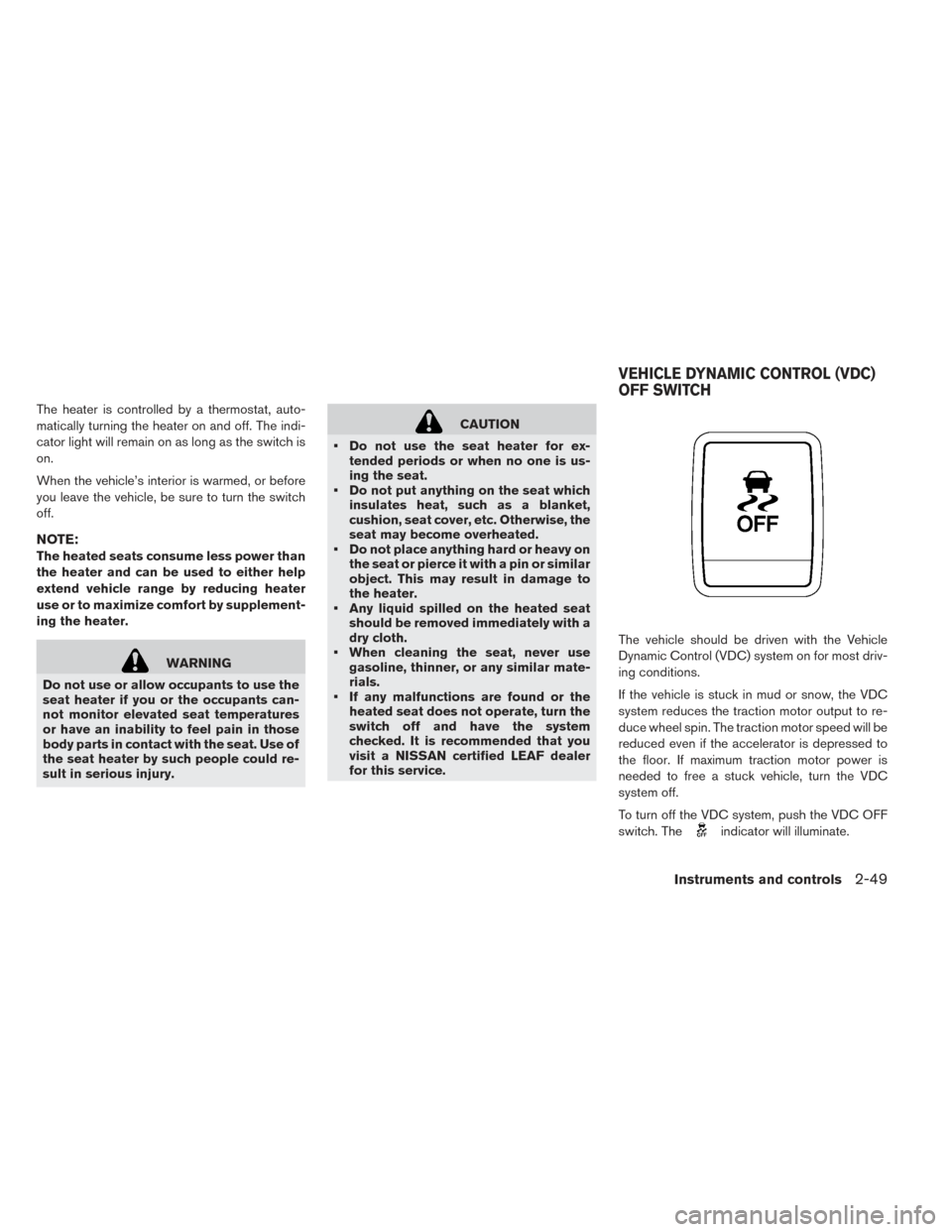
The heater is controlled by a thermostat, auto-
matically turning the heater on and off. The indi-
cator light will remain on as long as the switch is
on.
When the vehicle’s interior is warmed, or before
you leave the vehicle, be sure to turn the switch
off.
NOTE:
The heated seats consume less power than
the heater and can be used to either help
extend vehicle range by reducing heater
use or to maximize comfort by supplement-
ing the heater.
WARNING
Do not use or allow occupants to use the
seat heater if you or the occupants can-
not monitor elevated seat temperatures
or have an inability to feel pain in those
body parts in contact with the seat. Use of
the seat heater by such people could re-
sult in serious injury.
CAUTION
• Do not use the seat heater for ex- tended periods or when no one is us-
ing the seat.
• Do not put anything on the seat which insulates heat, such as a blanket,
cushion, seat cover, etc. Otherwise, the
seat may become overheated.
• Do not place anything hard or heavy on the seat or pierce it with a pin or similar
object. This may result in damage to
the heater.
• Any liquid spilled on the heated seat should be removed immediately with a
dry cloth.
• When cleaning the seat, never use gasoline, thinner, or any similar mate-
rials.
• If any malfunctions are found or the heated seat does not operate, turn the
switch off and have the system
checked. It is recommended that you
visit a NISSAN certified LEAF dealer
for this service. The vehicle should be driven with the Vehicle
Dynamic Control (VDC) system on for most driv-
ing conditions.
If the vehicle is stuck in mud or snow, the VDC
system reduces the traction motor output to re-
duce wheel spin. The traction motor speed will be
reduced even if the accelerator is depressed to
the floor. If maximum traction motor power is
needed to free a stuck vehicle, turn the VDC
system off.
To turn off the VDC system, push the VDC OFF
switch. The
indicator will illuminate.
VEHICLE DYNAMIC CONTROL (VDC)
OFF SWITCH
Instruments and controls2-49
Page 268 of 424
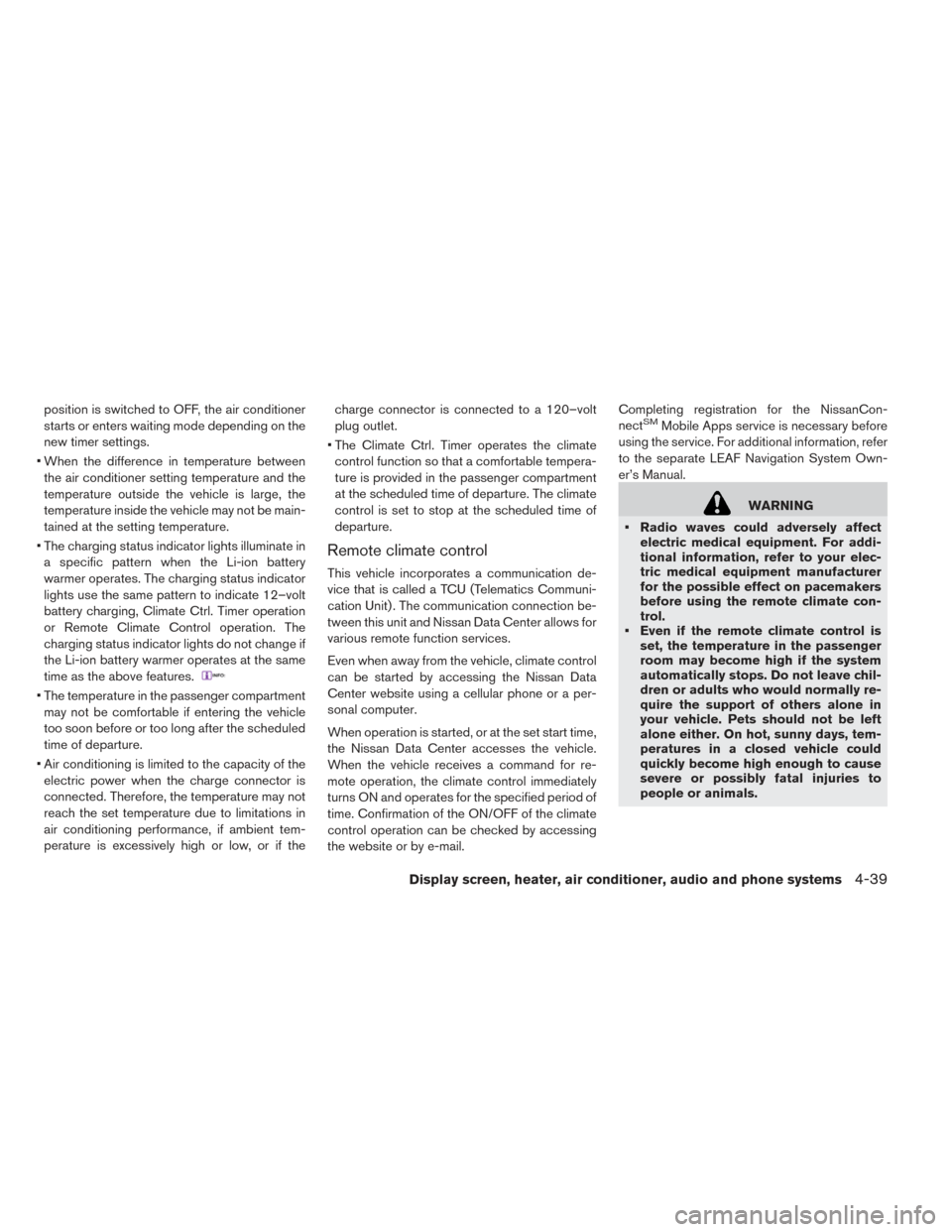
position is switched to OFF, the air conditioner
starts or enters waiting mode depending on the
new timer settings.
• When the difference in temperature between the air conditioner setting temperature and the
temperature outside the vehicle is large, the
temperature inside the vehicle may not be main-
tained at the setting temperature.
• The charging status indicator lights illuminate in a specific pattern when the Li-ion battery
warmer operates. The charging status indicator
lights use the same pattern to indicate 12–volt
battery charging, Climate Ctrl. Timer operation
or Remote Climate Control operation. The
charging status indicator lights do not change if
the Li-ion battery warmer operates at the same
time as the above features.
• The temperature in the passenger compartmentmay not be comfortable if entering the vehicle
too soon before or too long after the scheduled
time of departure.
• Air conditioning is limited to the capacity of the electric power when the charge connector is
connected. Therefore, the temperature may not
reach the set temperature due to limitations in
air conditioning performance, if ambient tem-
perature is excessively high or low, or if the charge connector is connected to a 120–volt
plug outlet.
• The Climate Ctrl. Timer operates the climate control function so that a comfortable tempera-
ture is provided in the passenger compartment
at the scheduled time of departure. The climate
control is set to stop at the scheduled time of
departure.
Remote climate control
This vehicle incorporates a communication de-
vice that is called a TCU (Telematics Communi-
cation Unit) . The communication connection be-
tween this unit and Nissan Data Center allows for
various remote function services.
Even when away from the vehicle, climate control
can be started by accessing the Nissan Data
Center website using a cellular phone or a per-
sonal computer.
When operation is started, or at the set start time,
the Nissan Data Center accesses the vehicle.
When the vehicle receives a command for re-
mote operation, the climate control immediately
turns ON and operates for the specified period of
time. Confirmation of the ON/OFF of the climate
control operation can be checked by accessing
the website or by e-mail. Completing registration for the NissanCon-
nect
SMMobile Apps service is necessary before
using the service. For additional information, refer
to the separate LEAF Navigation System Own-
er’s Manual.
WARNING
• Radio waves could adversely affect electric medical equipment. For addi-
tional information, refer to your elec-
tric medical equipment manufacturer
for the possible effect on pacemakers
before using the remote climate con-
trol.
• Even if the remote climate control is set, the temperature in the passenger
room may become high if the system
automatically stops. Do not leave chil-
dren or adults who would normally re-
quire the support of others alone in
your vehicle. Pets should not be left
alone either. On hot, sunny days, tem-
peratures in a closed vehicle could
quickly become high enough to cause
severe or possibly fatal injuries to
people or animals.
Display screen, heater, air conditioner, audio and phone systems4-39
Page 326 of 424
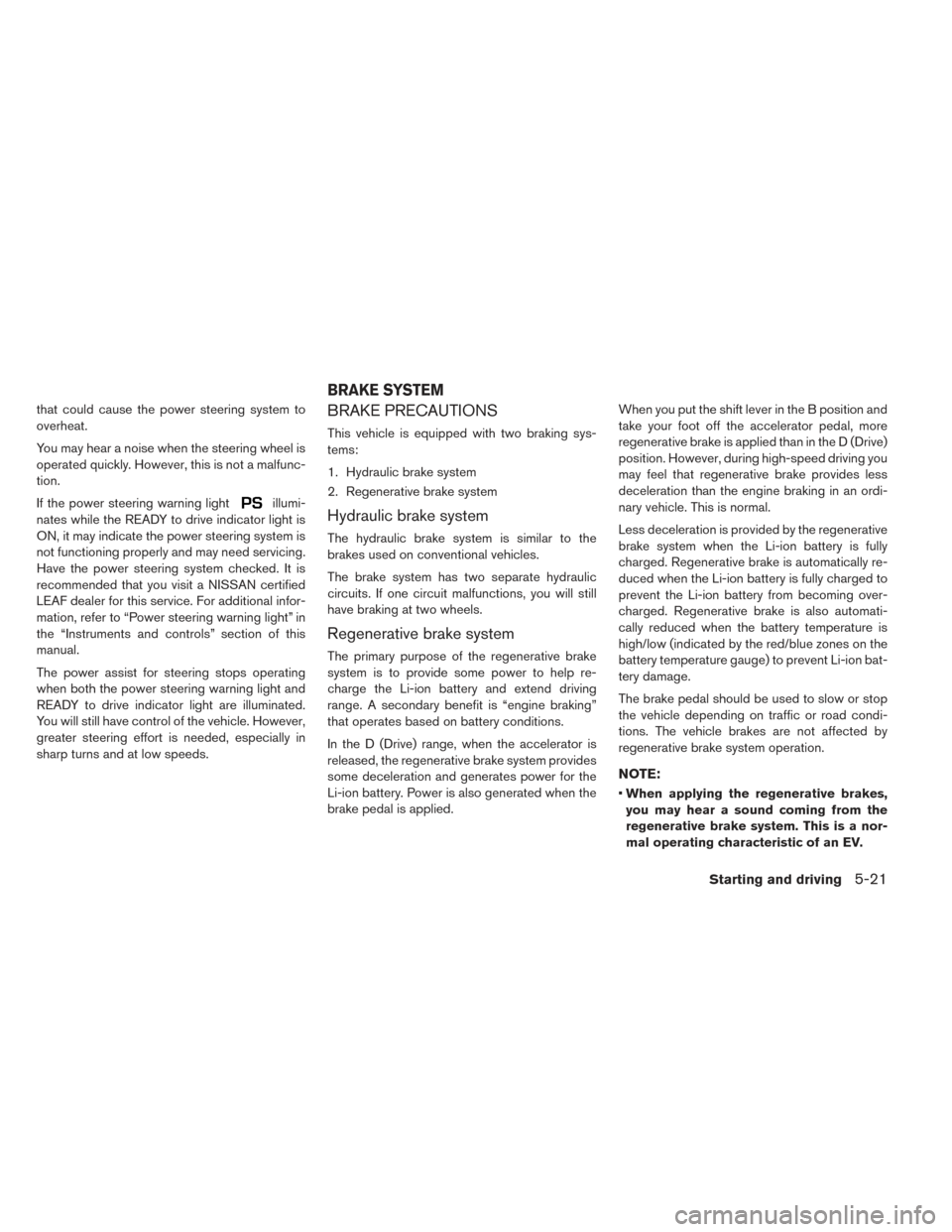
that could cause the power steering system to
overheat.
You may hear a noise when the steering wheel is
operated quickly. However, this is not a malfunc-
tion.
If the power steering warning light
illumi-
nates while the READY to drive indicator light is
ON, it may indicate the power steering system is
not functioning properly and may need servicing.
Have the power steering system checked. It is
recommended that you visit a NISSAN certified
LEAF dealer for this service. For additional infor-
mation, refer to “Power steering warning light” in
the “Instruments and controls” section of this
manual.
The power assist for steering stops operating
when both the power steering warning light and
READY to drive indicator light are illuminated.
You will still have control of the vehicle. However,
greater steering effort is needed, especially in
sharp turns and at low speeds.
BRAKE PRECAUTIONS
This vehicle is equipped with two braking sys-
tems:
1. Hydraulic brake system
2. Regenerative brake system
Hydraulic brake system
The hydraulic brake system is similar to the
brakes used on conventional vehicles.
The brake system has two separate hydraulic
circuits. If one circuit malfunctions, you will still
have braking at two wheels.
Regenerative brake system
The primary purpose of the regenerative brake
system is to provide some power to help re-
charge the Li-ion battery and extend driving
range. A secondary benefit is “engine braking”
that operates based on battery conditions.
In the D (Drive) range, when the accelerator is
released, the regenerative brake system provides
some deceleration and generates power for the
Li-ion battery. Power is also generated when the
brake pedal is applied. When you put the shift lever in the B position and
take your foot off the accelerator pedal, more
regenerative brake is applied than in the D (Drive)
position. However, during high-speed driving you
may feel that regenerative brake provides less
deceleration than the engine braking in an ordi-
nary vehicle. This is normal.
Less deceleration is provided by the regenerative
brake system when the Li-ion battery is fully
charged. Regenerative brake is automatically re-
duced when the Li-ion battery is fully charged to
prevent the Li-ion battery from becoming over-
charged. Regenerative brake is also automati-
cally reduced when the battery temperature is
high/low (indicated by the red/blue zones on the
battery temperature gauge) to prevent Li-ion bat-
tery damage.
The brake pedal should be used to slow or stop
the vehicle depending on traffic or road condi-
tions. The vehicle brakes are not affected by
regenerative brake system operation.
NOTE:
•
When applying the regenerative brakes,
you may hear a sound coming from the
regenerative brake system. This is a nor-
mal operating characteristic of an EV.
BRAKE SYSTEM
Starting and driving5-21
Page 336 of 424
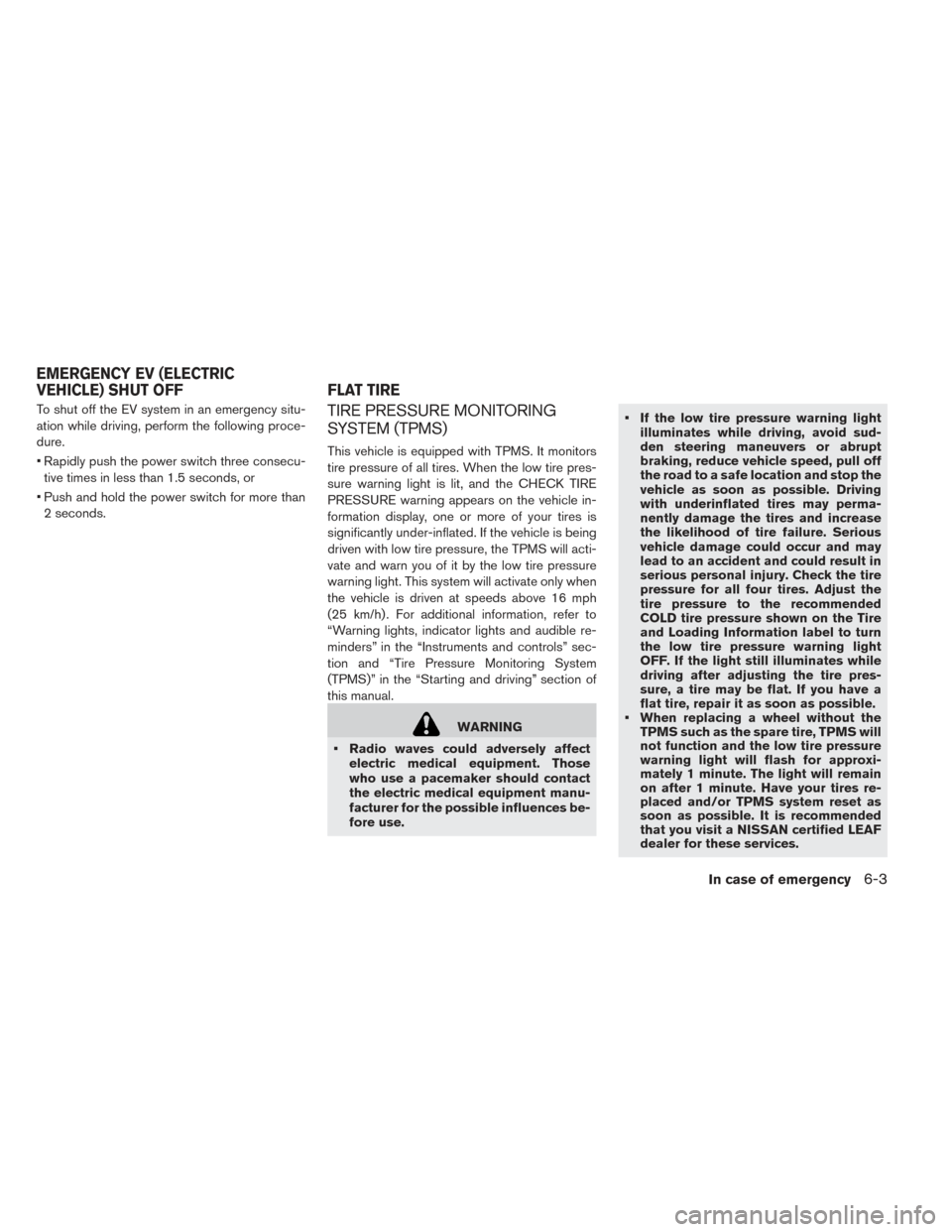
To shut off the EV system in an emergency situ-
ation while driving, perform the following proce-
dure.
• Rapidly push the power switch three consecu-tive times in less than 1.5 seconds, or
• Push and hold the power switch for more than 2 seconds.TIRE PRESSURE MONITORING
SYSTEM (TPMS)
This vehicle is equipped with TPMS. It monitors
tire pressure of all tires. When the low tire pres-
sure warning light is lit, and the CHECK TIRE
PRESSURE warning appears on the vehicle in-
formation display, one or more of your tires is
significantly under-inflated. If the vehicle is being
driven with low tire pressure, the TPMS will acti-
vate and warn you of it by the low tire pressure
warning light. This system will activate only when
the vehicle is driven at speeds above 16 mph
(25 km/h) . For additional information, refer to
“Warning lights, indicator lights and audible re-
minders” in the “Instruments and controls” sec-
tion and “Tire Pressure Monitoring System
(TPMS)” in the “Starting and driving” section of
this manual.
WARNING
• Radio waves could adversely affect electric medical equipment. Those
who use a pacemaker should contact
the electric medical equipment manu-
facturer for the possible influences be-
fore use. • If the low tire pressure warning light
illuminates while driving, avoid sud-
den steering maneuvers or abrupt
braking, reduce vehicle speed, pull off
the road to a safe location and stop the
vehicle as soon as possible. Driving
with underinflated tires may perma-
nently damage the tires and increase
the likelihood of tire failure. Serious
vehicle damage could occur and may
lead to an accident and could result in
serious personal injury. Check the tire
pressure for all four tires. Adjust the
tire pressure to the recommended
COLD tire pressure shown on the Tire
and Loading Information label to turn
the low tire pressure warning light
OFF. If the light still illuminates while
driving after adjusting the tire pres-
sure, a tire may be flat. If you have a
flat tire, repair it as soon as possible.
• When replacing a wheel without the TPMS such as the spare tire, TPMS will
not function and the low tire pressure
warning light will flash for approxi-
mately 1 minute. The light will remain
on after 1 minute. Have your tires re-
placed and/or TPMS system reset as
soon as possible. It is recommended
that you visit a NISSAN certified LEAF
dealer for these services.
EMERGENCY EV (ELECTRIC
VEHICLE) SHUT OFF FLAT TIRE
In case of emergency6-3
Page 363 of 424
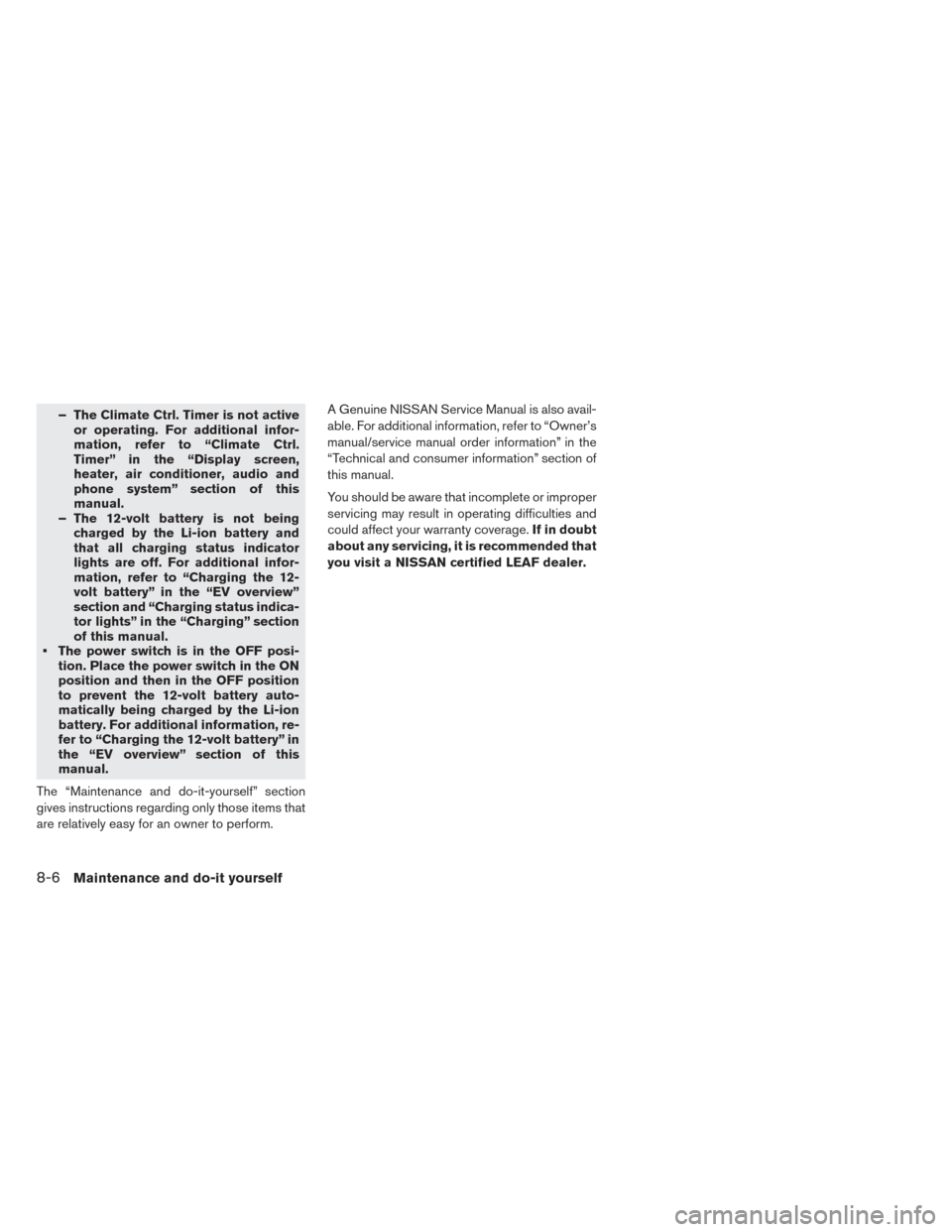
– The Climate Ctrl. Timer is not activeor operating. For additional infor-
mation, refer to “Climate Ctrl.
Timer” in the “Display screen,
heater, air conditioner, audio and
phone system” section of this
manual.
– The 12-volt battery is not being charged by the Li-ion battery and
that all charging status indicator
lights are off. For additional infor-
mation, refer to “Charging the 12-
volt battery” in the “EV overview”
section and “Charging status indica-
tor lights” in the “Charging” section
of this manual.
• The power switch is in the OFF posi- tion. Place the power switch in the ON
position and then in the OFF position
to prevent the 12-volt battery auto-
matically being charged by the Li-ion
battery. For additional information, re-
fer to “Charging the 12-volt battery” in
the “EV overview” section of this
manual.
The “Maintenance and do-it-yourself” section
gives instructions regarding only those items that
are relatively easy for an owner to perform. A Genuine NISSAN Service Manual is also avail-
able. For additional information, refer to “Owner’s
manual/service manual order information” in the
“Technical and consumer information” section of
this manual.
You should be aware that incomplete or improper
servicing may result in operating difficulties and
could affect your warranty coverage.
If in doubt
about any servicing, it is recommended that
you visit a NISSAN certified LEAF dealer.
8-6Maintenance and do-it yourself
Page 417 of 424
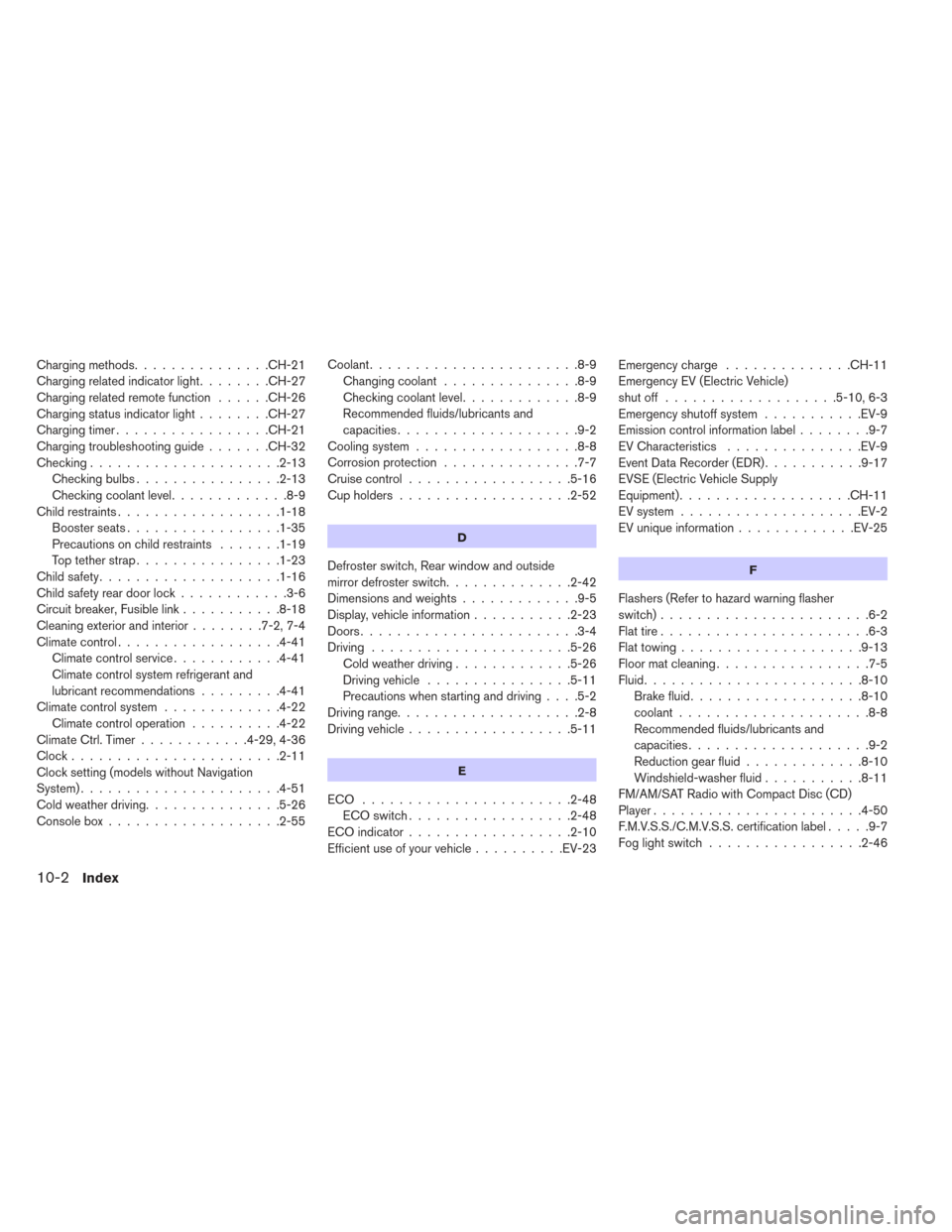
Charging methods...............CH-21
Chargingrelatedindicatorlight........CH-27
Charging related remote function ......CH-26
Charging status indicator light ........CH-27
Chargingtimer.................CH-21
Charging troubleshooting guide .......CH-32
Checking .....................2-13
Checkingbulbs................2-13
Checkingcoolantlevel.............8-9
Child restraints ..................1-18
Boosterseats.................1-35
Precautions on child restraints .......1-19
Top tether strap ................1-23
Childsafety....................1-16
Child safety rear door lock ............3-6
Circuit breaker, Fusible link ...........8-18
Cleaning exterior and interior ........7-2,7-4
Climatecontrol..................4-41 Climate control service ............4-41
Climate control system refrigerant and
lubricant recommendations .........4-41
Climate control system .............4-22
Climate control operation ..........4-22
Climate Ctrl. Timer ............4-29,4-36
Clock.......................2-11
Clock setting (models without Navigation
System) ......................4-51
Cold weather driving ...............5-26
Consolebox...................2-55 Coolant
.......................8-9
Changingcoolant ...............8-9
Checking coolant level .............8-9
Recommended fluids/lubricants and
capacities ....................9-2
Cooling system ..................8-8
Corrosion protection ...............7-7
Cruisecontrol..................5-16
Cupholders...................2-52
D
Defroster switch, Rear window and outside
mirror defroster switch ..............2-42
Dimensionsandweights.............9-5
Display, vehicle information ...........2-23
Doors ........................3-4
Driving ......................5-26
Cold weather driving .............5-26
Driving vehicle ................5-11
Precautions when starting and driving ....5-2
Driving range ....................2-8
Driving vehicle ..................5-11
E
ECO .......................2-48
ECO switch ..................2-48
ECOindicator..................2-10
Efficient use of your vehicle ..........EV-23Emergencycharge ..............CH-11
Emergency EV (Electric Vehicle)
shutoff ...................5-10,6-3
Emergency shutoff system
...........EV-9
Emission control information label ........9-7
EV Characteristics ...............EV-9
Event Data Recorder (EDR) ...........9-17
EVSE (Electric Vehicle Supply
Equipment) ...................CH-11
EV system ....................EV-2
EV unique information .............EV-25
F
Flashers (Refer to hazard warning flasher
switch).......................6-2
Flat tire .......................6-3
Flattowing....................9-13
Floormatcleaning.................7-5
Fluid ........................8-10
Brake fluid ...................8-10
coolant.....................8-8
Recommended fluids/lubricants and
capacities ....................9-2
Reduction gear fluid .............8-10
Windshield-washer fluid ...........8-11
FM/AM/SAT Radio with Compact Disc (CD)
Player .......................4-50
F.M.V.S.S./C.M.V.S.S. certification label .....9-7
Foglightswitch .................2-46
10-2Index
Page 419 of 424
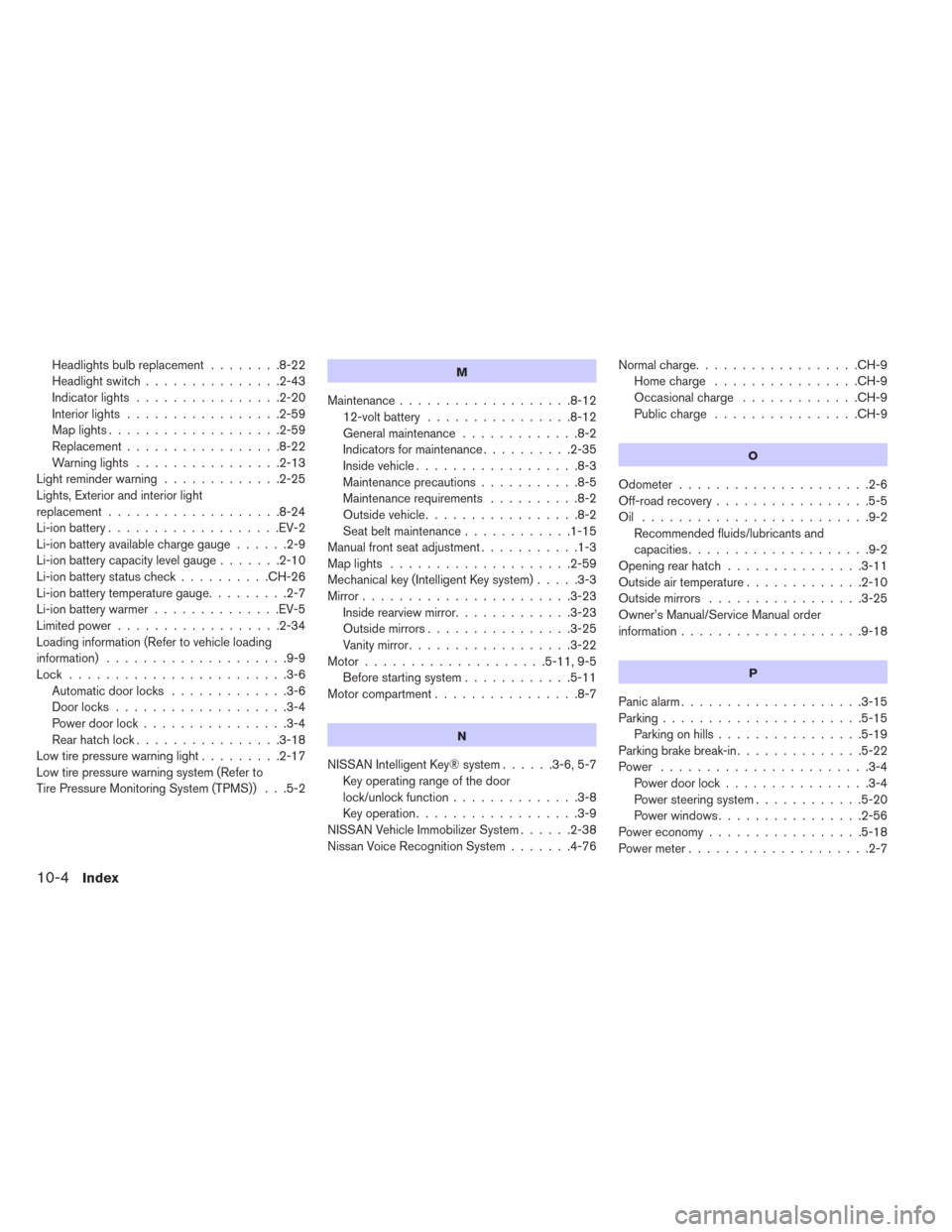
Headlights bulb replacement........8-22
Headlightswitch...............2-43
Indicatorlights ................2-20
Interior lights .................2-59
Maplights...................2-59
Replacement .................8-22
Warninglights ................2-13
Light reminder warning .............2-25
Lights, Exterior and interior light
replacement ...................8-24
Li-ion battery ...................EV-2
Li-ion battery available charge gauge ......2-9
Li-ion battery capacity level gauge .......2-10
Li-ion battery status check ..........CH-26
Li-ion battery temperature gauge .........2-7
Li-ion battery warmer ..............EV-5
Limited power ..................2-34
Loading information (Refer to vehicle loading
information) ....................9-9
Lock ........................3-6
Automatic door locks .............3-6
Door locks ...................3-4
Power door lock ................3-4
Rearhatchlock................3-18
Low tire pressure warning light .........2-17
Low tire pressure warning system (Refer to
Tire Pressure Monitoring System (TPMS)) . . .5-2M
Maintenance...................8-12 12-volt battery ................8-12
General maintenance .............8-2
Indicators for maintenance ..........2-35
Insidevehicle..................8-3
Maintenanceprecautions...........8-5
Maintenance requirements ..........8-2
Outside vehicle .................8-2
Seat belt maintenance ............1-15
Manual front seat adjustment ...........1-3
Maplights ....................2-59
Mechanical key (Intelligent Key system) .....3-3
Mirror .......................3-23
Inside rearview mirror.............3-23
Outside mirrors ................3-25
Vanity mirror ..................3-22
Motor....................5-11,9-5 Before starting system ............5-11
Motor compartment ................8-7
N
NISSAN Intelligent Key® system ......3-6,5-7
Key operating range of the door
lock/unlock function ..............3-8
Key operation ..................3-9
NISSAN Vehicle Immobilizer System ......2-38
Nissan Voice Recognition System .......4-76Normal charge..................CH-9
Home charge ................CH-9
Occasional charge .............CH-9
Publiccharge ................CH-9
O
Odometer .....................2-6
Off-road recovery .................5-5
Oil .........................9-2 Recommended fluids/lubricants and
capacities ....................9-2
Openingrearhatch...............3-11
Outside air temperature .............2-10
Outside mirrors .................3-25
Owner’s Manual/Service Manual order
information ....................9-18
P
Panic alarm....................3-15
Parking ......................5-15
Parking on hills ................5-19
Parking brake break-in ..............5-22
Power .......................3-4 Power door lock ................3-4
Power steering system ............5-20
Power windows ................2-56
Powereconomy.................5-18
Powermeter....................2-7
10-4Index